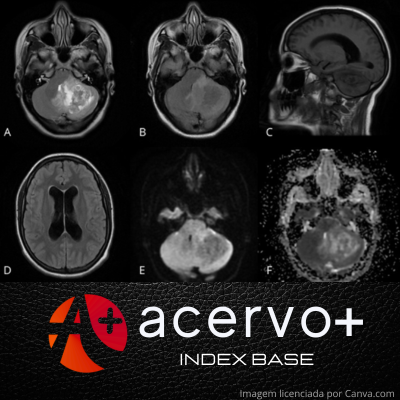Criptococoma cerebelar simulando neoplasia metastática em uma paciente oncológica
##plugins.themes.bootstrap3.article.main##
Resumo
Objetivo: Relatar um caso raro de criptococoma cerebelar mimetizando metástase em uma paciente oncológica, destacando a importância do diagnóstico diferencial e do manejo adequado de infecções fúngicas oportunistas. Detalhamento do caso: Mulher de 22 anos, previamente imunocompetente, com diagnóstico de câncer cervical, foi submetida a quimioterapia e radioterapia. Durante o tratamento, desenvolveu sintomas neurológicos, incluindo cefaleia e tremor no membro superior esquerdo. A ressonância magnética craniana revelou uma lesão expansiva no cerebelo, com características sugestivas de metástase, além de sinais de hidrocefalia obstrutiva. Optou-se por intervenção cirúrgica com ressecção da lesão. O exame histopatológico revelou a presença de Cryptococcus neoformans, confirmando o diagnóstico de criptococoma cerebelar. Apesar de seu estado imunológico previamente íntegro, a paciente apresentou imunossupressão secundária ao tratamento oncológico, favorecendo a infecção fúngica. Foram necessários procedimentos adicionais, como correção de fístula liquórica e derivação ventrículoperitoneal para controle da hidrocefalia. O tratamento antifúngico foi instituído com boa evolução clínica. Considerações finais: Este caso enfatiza a relevância do diagnóstico diferencial de lesões cerebelares em pacientes oncológicos, especialmente em cenários em que metástases são altamente suspeitas. O reconhecimento precoce e o manejo adequado são essenciais para evitar complicações neurológicas graves e melhorar o prognóstico.
##plugins.themes.bootstrap3.article.details##
Copyright © | Todos os direitos reservados.
A revista detém os direitos autorais exclusivos de publicação deste artigo nos termos da lei 9610/98.
Reprodução parcial
É livre o uso de partes do texto, figuras e questionário do artigo, sendo obrigatória a citação dos autores e revista.
Reprodução total
É expressamente proibida, devendo ser autorizada pela revista.
Referências
2. BRUNASSO L, et al. Seizure in isolated brain cryptococcoma: Case report and review of the literature. Surg Neurol Int, 2021; 12: 153.
3. CHANG SC, et al. Diffusion-weighted MRI features of brain abscess and cystic or necrotic brain tumors: comparison with conventional MRI. Clin Imaging, 2002; 26: 227-36.
4. DUARTE SBL, et al. Magnetic resonance imaging findings in central nervous system cryptococcosis: comparison between immunocompetent and immunocompromised patients. Radiol Bras, 2017; 50: 359-65.
5. GANGADHARAN SS, RAVEENDRANATH S. Cryptococcosis in oncology patients: a case series in a tertiary care cancer centre. Iran J Microbiol, 2023.
6. GAVITO-HIGUERA J, et al. Fungal infections of the central nervous system: A pictorial review. J Clin Imaging Sci, 2016; 6: 24.
7. KAMBUGU A, et al. Outcomes of cryptococcal meningitis in Uganda before and after the availability of highly active antiretroviral therapy. Clin Infect Dis, 2008; 46: 1694-701.
8. KAWAGUCHI T, et al. Successful treatment of disseminated cryptococcosis with liposomal amphotericin B and isavuconazole in an adult living with HIV: A case report and literature review. Journal of Infection and Chemotherapy, 2025; 31(1): 102534.
9. KLOCK C, et al. Histopathological aspects of neurocryptococcosis in HIV-infected patients: autopsy report of 45 patients. Int J Surg Pathol, 2009; 17: 444-8.
10. LI Y, et al. Microbiological, epidemiological, and clinical characteristics of patients with Cryptococcal meningitis at a tertiary hospital in China: A 6-year retrospective analysis. Frontiers in Microbiology, 2020; 11: 1837.
11. MACHADO M, et al. Criptococoma cerebral e pulmonar em paciente imunocompetente: relato de caso. Arquivos Brasileiros de Neurocirurgia Brazilian Neurosurgery, 2015; 34(4): 335-337.
12. MAY RC, et al. Cryptococcus: from environmental saprophyte to global pathogen. Nat Rev Microbiol, 2016; 14: 106-17.
13. MBANGIWA T, et al. Development and validation of quantitative PCR assays for HIV-associated cryptococcal meningitis in sub-Saharan Africa: a diagnostic accuracy study. The Lancet Microbe, 2024; 5(3): e261-e271.
14. OLIVEIRA EP, et al. Clinical and epidemiological characteristics of neurocryptococcosis associated with HIV in northeastern Brazil. Viruses, 2023; 15.
15. PAIVA ALC, et al. Cryptococcoma mimicking a brain tumor in an immunocompetent patient: case report of an extremely rare presentation. São Paulo Med J, 2018; 136: 492-6.
16. POLEY M, et al. Meningite criptocócica em um paciente aparentemente imunocompetente. J Investig Med High Impact Case Rep, v. 7, 2019.
17. ROCHA MF, et al. Reframing the clinical phenotype and management of cryptococcal meningitis. Pract Neurol, 2024; n-2024-004133.
18. SANTANDER XA, et al. Intraventricular cryptococcoma mimicking a neoplastic lesion in an immunocompetent patient with hydrocephalus: A case report. Surg Neurol Int, 2019; 10: 115.
19. SCHMALZLE SA, et al. Cryptococcus neoformans infection in malignancy. Mycoses, 2016; 59(9): 542-552.
20. SILLERO-FILHO VJ, et al. Cerebellar cryptococcoma simulating metastatic neoplasm. Arq Neuropsiquiatr, 2009; 67: 290-2.
21. TSENG H-K, et al. How Cryptococcus interacts with the blood-brain barrier. Future Microbiol, 2015; 10: 1669-82.
22. XIA S, LI X, LI H. Imaging characterization of cryptococcal meningoencephalitis. Radiol Infect Dis, 2016; 3: 187-91.
23. ZHANG J, et al. Antifungal susceptibility and molecular characteristics of Cryptococcus spp. based on whole-genome sequencing in Zhejiang Province, China. Front. Microbiol., 2022; 13: 991703.

